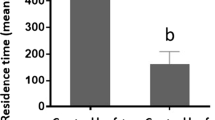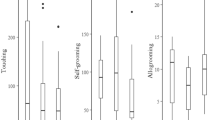Abstract
Foraging in trees by the Argentine ant,Iridomyrmex humilis (Mayr), was disrupted by a variety of synthetic chemicals, with the most effective chemical being farnesol. Testing of substrates for presentation of the disruptant chemicals gave some success with rubber or Tygon tubing, although best results were obtained through incorporation of the material into Stikem, which was then banded around tree trunks. Amounts of farnesol used for effective, long residual ant control were between 0.8 and 2 g per tree.
Similar content being viewed by others
References
Benthuysen, J.L., andBlum, M.S. 1964. Quantitative sensitivity of the antPogonomyrmex barbatus to enantiomers of its alarm pheromone.J. Ga. Entomol. Soc. 9:235–238.
Blum, M.S., Water, S.L., andTraynham, J.G. 1966. Chemical releasers of social behavior, VI: the relation of structure to activity of ketones as releasers of alarm forIridomyrmex pruinosus (Roger).J. Insect Physiol. 12:419–427.
Blum, M.S., Padovani, F., andAmante, E. 1968. Alkanes and terpenes in the mandibular glands ofAtta species.Comp. Biochem. Physiol. 26:291–299.
Bueno, O.C., Hebling-Beraldo, M.J.A., Aulina da Silva, O., Pagnocca, F., Fernandez, J.B., andVieira, P.L. 1990. Toxic effect of plants on leaf-cutting ants and their symbiotic fungus, pp. 420–426, in R.K. Vander Meer, K. Jaffe, and A. Cedeno (eds.). Applied Myrmecology. Westview Press, San Francisco.
Butenandt, A., Linzen, B., andLindauer, M. 1959. Ueber einen Duftstoff aus der Mandibeldruese der BlattschneiderameiseAtta sexdens rubropilosa Forel.Arch. Anat. Microsc. Morphol. Exp. 48:13–19.
Cavill, G.W.K., andHoughton, E. 1974. Volatile constituents of the Argentine ant,Iridomyrmex humilis.J. Insect Physiol. 20:2049–2060.
Henderson, G., andJeanne, R.L. 1989. Response of aphid-tending ants to a repellent produced by wasps (Hymenoptera: Formicidae, Vespidae).Ann. Entomol. Soc. Am. 82:516–519.
Hölldobler, B. 1977. Communication in social Hymenoptera, pp. 418–471,in T.A. Sebeok (ed.). How Animals Communicate. Indiana University Press, Bloomington, Indiana.
Hölldobler, B., andWilson, E.O. 1990. The Ants. Belknap Press, Cambridge, Massachusetts, 732 pp.
Honda, K. 1983. Defensive potential of components of the larval osmeterial secretion of papilionid caterpillars against ants.Physiol. Entomol. 8:173–179.
Howard, J.J. 1987. Leaf-cutting ant diet selection: The role of nutrients, water, and secondary chemistry.Ecology 68:503–515.
Howard, J.J., Cazin, J., Jr., andWiemer, D.F. 1988. Toxicity of terpenoid deterrents to the leafcutting antAtta cephalotes and its mutualistic fungus.J. Chem. Ecol. 14:59–69.
Howard, J.J., Green, T.P., andWiener, D.F. 1989. Comparative deterrency of two terpenoids to two genera of attine ants.J. Chem. Ecol. 15:2279–2288.
Hubbell, S.P., Wiemer, D.F., andAdejare, A. 1983. An antifungal terpenoid defends a neotropical tree (Hymnanea) against attack by fungus-growing ants.Oecologia 60:321–327.
Hubbell, S.P., Howard, J.J., andWiemer, D.F. 1984. Chemical repellency to an attine ant: Seasonal distribution among potential host-plant species:Ecology 65:1067–1076.
Huth, A., andDettner, K. 1990. Defense chemicals from abdominal glands of thirteen rove beetle species of the subtribe Staphylina (Coleoptera: Staphylinidae: Staphylininae).J. Chem. Ecol. 16:2691–2711.
Jeanne, R.L. 1975. The adaptedness of social wasp nest architecture.Q. Rev. Biol. 50:267–287.
Key, S.E.V.V., Baker, T.C., andGaston, L.K. 1981. Effects of gaster extract trail concentration on trail following behavior in the Argentine ant,Iridomyrmex humilis.J. Insect Physiol. 27:363–370.
Kistner, D.H., andBlum, M.S. 1971. Alarm pheromone ofLasius (Dendrolasius)spathepus (Hymenoptera: Formicidae) and its possible mimicry by two species ofPella (Coleoptera: Staphylinidae).Ann. Entomol. Soc. Am. 64:589–594.
Lloyd, H.A., Blum, M.S., Snelling, R.R., andEvans, S.L. 1989. Chemistry of mandibular and Dufour's gland secretions of ants in genusMyrmecocystus.J. Chem. Ecol. 15:2589–2599.
Maschwitz, U. 1964. Gefahrenalarmstoffe and Gefahrenalarmierung bei sozialen Hymenoptera.Z. Vergl. Physiol. 47:569–655.
Post, D.C., andJeanne, R.L. 1981. Colony defense against ants byPolistes fuscatus (Hymenoptera: Vespidae) in Wisconsin.J. Kans. Entomol. Soc. 54:599–615.
Post, D.C., Mohamed, M.A., Goppel, H.C., andJeanne, R.L. 1984. Identification of ant repellent allomone produced by social waspPolistes fiiscatus (Hymenoptera: Vespidae).J. Chem. Ecol. 10:1799–1807.
Regnier, F.E., andWilson, E.O. 1968. The alarm-defense system of the antAcanthomyops claviger.J. Insect Physiol. 14:955–970.
Riley, R.G., Silverstein, R.M., andMoser, J.C. 1974. Isolation, identification, synthesis, and biological activity of volatile compounds from the heads ofAtta ants.I. Insect Physiol. 20:1629–1637.
Scheffrahn, R.H., Gaston, L.K., Sims, J.J., andRust, M.K. 1983. Identification of the defensive secretion from soldiers of the North American termite,Amitermes wheeleri (Desneux) (Isoptera: Termitidae).J. Chem. Ecol. 9:1293–1305.
Scheffrahn, R.H., Sims, J.J., Gaston, L.K., andRust, M.K. 1984a. 4, 11-Epoxy-cis-eudesmane, soldier cephalic secretion of the Nearctic Desert termite,Amitermes minimus Light (Termitidae: Termitinae).Experientia 40:1136–1137.
Scheffrahn, R.H., Gaston, L.K., Sims, J.J., andRust, M.K. 1984b. Defensive ecology ofForelius foetidus and its chemosystematic relationship to F.(=Iridomyrmex)pruinosus (Hymenoptera: Formicidae: Dolichoderinae).Environ. Entomol. 13:1502–1506.
Schildknecht, H. 1976. Chemical ecology-a chapter of modern natural products chemistry.Angew. Chem. Int. Ed. Eng. 151:214–222.
Author information
Authors and Affiliations
Rights and permissions
About this article
Cite this article
Shorey, H.H., Gaston, L.K., Gerber, R.G. et al. Disruption of foraging by argentine ants,Iridomyrmex humilis (mayr) (hymenoptera: Formicidae), in citrus trees through the use of semiochemicals and related chemicals. J Chem Ecol 18, 2131–2142 (1992). https://doi.org/10.1007/BF00981933
Received:
Accepted:
Issue Date:
DOI: https://doi.org/10.1007/BF00981933




